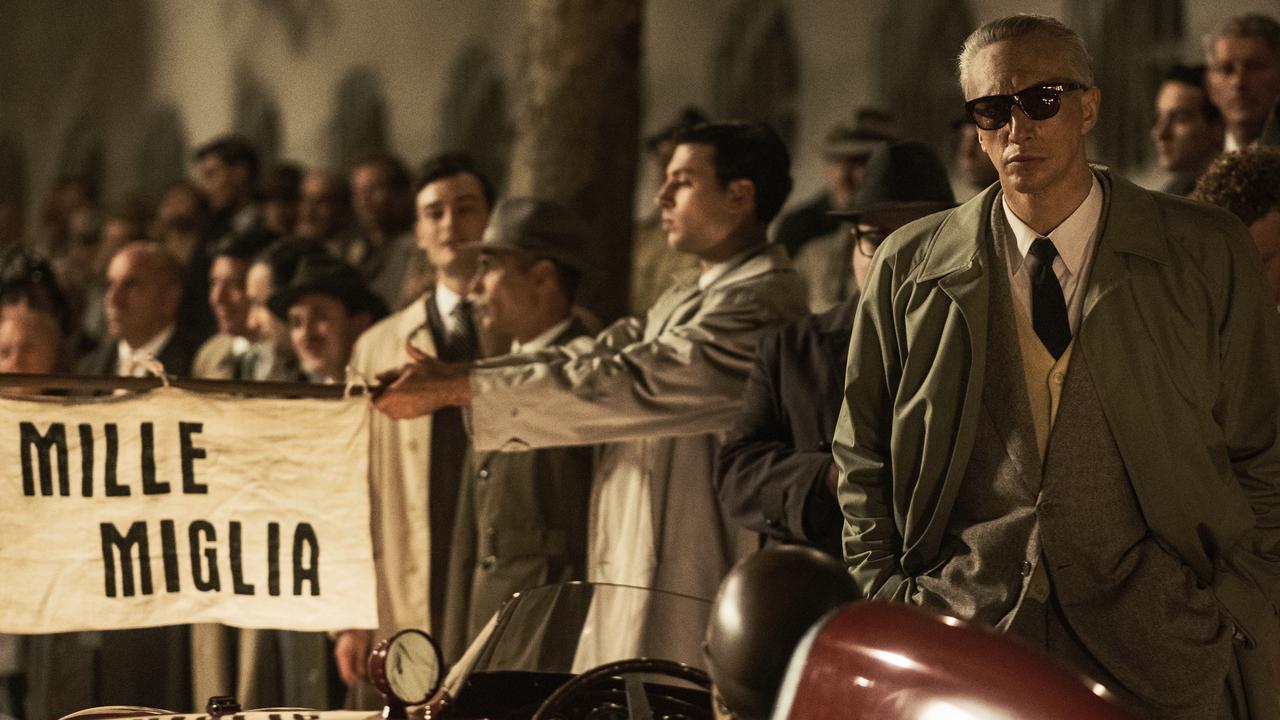
In his latest film, which focuses on the iconic figure of racing car culture, Michael Mann returned to the charming Italian town that he couldn’t bear to leave behind in his rearview mirror.
Michael Mann’s vision of creating a film about the legendary automobile tycoon Enzo Ferrari began over 25 years ago. Despite the script undergoing various transformations and modifications over the years, filming the movie in Modena, Ferrari’s birthplace in northern Italy, was always a certainty.
“I first visited Modena in 1995,” Mann reminisces. “When I look at old location photographs from that time, I see myself with brown hair – it takes me back and makes me feel 25 years younger.”
Although many successful entrepreneurs leave their hometowns in search of more glamorous and expansive environments, Enzo Ferrari remained a true local at heart. Born in Modena in 1898, he passed away there in 1988 and never ventured too far from the city throughout his life. In fact, he even chose to incorporate Modena’s official color, yellow, as the backdrop for the iconic Ferrari emblem, ensuring that the city would always be considered the company’s true home.
“Modena is a truly exceptional place where people tend to stay put,” Mann remarks. “Ferrari embodied this mindset and in the mid-1950s, he made a conscious decision not to travel abroad for races. Instead, on Saturdays, he would gather with Sergio Scaglietti, Ferrari’s bodywork designer, and they would light a fire in a 50-gallon oil drum, cook chicken, and listen to the races on the radio.”

Modena today remains much the same as when Mann first visited many years ago, or when Ferrari called it home. The city exudes an ornate and peaceful atmosphere, with a sense of timelessness that is palpable. As I stroll through the town on a crisp autumn day, the streets are ablaze with the afternoon sun, illuminating rows of buildings painted in a vibrant egg-yolk yellow reminiscent of fresh tortellini. Groups of people leisurely wander around grand Romanesque squares, while a monk – one of only two who reside in the city’s monastery – stops to chat with his parishioners. Locals sip on espressos at street-side tables and peruse the beautiful Art Nouveau covered market, examining fruit in the same manner they have for decades.
It’s hard to believe that I’m in the epicentre of the thundering, full-throttle world of luxury sports cars, which once roared through these ancient streets during the now-defunct Mille Miglia, at one point among the deadliest motor races in the world.
Modena is nestled in Italy’s Emilia-Romagna region, which boasts a remarkable number of claims to fame. It’s renowned for its gastronomic excellence, producing some of the country’s most iconic foods and housing some of the world’s best restaurants. The legendary opera singer Luciano Pavarotti was born here. However, the city’s nickname is “Motor City,” owing to the fact that Lamborghini, Pagani, De Tomaso, and Bugatti all manufacture their glossy supercars here. But in Modena, it’s Ferrari that has ingrained itself into the city’s psyche.
In Modena, it is clear that there are two dominant faiths: God and Ferrari.
Mann’s latest film, Ferrari, is set during a three-month period in 1957 and introduces us to the car magnate (portrayed by Adam Driver) as his professional and personal life begins to unravel. With his business struggling financially, Ferrari faces mounting pressure to win the Mille Miglia race to improve his fortunes. Meanwhile, he is still grieving the loss of his eldest son, and his marriage to Laura (played by Penélope Cruz) is falling apart. To make matters worse, he is also trying to balance a second home with his mistress, Lina Lardi (played by Shailene Woodley), and their son, Piero.
Amidst the chaos, the earthen-hued cityscape of Modena serves as a constant backdrop. Mann even enlisted Piero, now the vice president of the car company, to participate in the filming and provide insights into his father’s character, adding depth and authenticity to the portrayal of Ferrari’s everyday world.
“Modena is a tightly-knit community,” Mann explains. “The house we used for Ferrari is located right next to the opera, and just down the street is the barbershop Enzo frequented every morning. When Adam sat in the same chair where Enzo once sat, and the barber’s son shaved him, the resonance was palpable. Everything in Modena is compressed, and you can feel it.”

The film is replete with such subtle nods to Ferrari. The former chief mechanics of pro-racing drivers Niki Lauda and Michael Schumacher make cameo appearances, while engine blocks and other props were sourced from the Ferrari factory in Maranello, just 30 minutes away. Many scenes were shot on the very roads where Ferrari tests its cars today. “The history is way, way deep,” says Mann. “Modena is a wonderfully, organically authentic place. I could have shot part of the movie in Cinecittà in Rome and there wouldn’t have been anything like this.”
Today, the influence of Ferrari can be seen throughout Modena. The streets are filled with gleaming cars adorned with the iconic prancing horse logo, while the Da Antonio barbershop, where Enzo Ferrari used to get his morning shave, remains virtually unchanged and proudly displays a black-and-white photograph of its famous customer on the wall, along with a collection of miniature toy cars. Even the tour guide recalls seeing Ferrari walking the streets as a child, and stopping to say hello when he passed by. The history and legacy of Ferrari are deeply ingrained in the fabric of Modena, and can be felt in every corner of the city.
Janice Polley, the location manager for the film, who has collaborated with Mann since his 1992 movie The Last of the Mohicans, says, “Ferrari’s world is intertwined with every corner of Modena.” Whether it’s the sound of Ferrari engines, which Mann describes as “music,” echoing through the air while scouting for locations, or driving down seemingly ordinary rural roads that unexpectedly turn out to be supercar test routes, Ferrari’s legacy permeates every aspect of Modena.

During her search for historically accurate locations, Polley stumbled upon a poignant scene that forms the heart of Mann’s film. The scene depicts the tragic 1957 Mille Miglia crash, which claimed the life of Ferrari driver Alfonso de Portago, nine spectators (including four children), and marked the end of the race. “It was a challenging location to find because Michael wanted to use the actual road. He wanted everything to be historically accurate,” Polley explains. When she finally arrived at the original location and knocked on the door of a farmhouse, she was met by the brother of one of the children who had lost their life in the accident.
“It was a poignant moment,” Polley recalls. “I wasn’t expecting it. But there were many people with connections to the Mille Miglia and Ferrari. Every house I scouted had a story. People who lived there would invite me in and show me photos, and some of them had incredible car collections. Everyone is tied to Ferrari in some way; their family worked there or they were part of it.”
The filming of “Ferrari” was a swift process, taking place between August and October 2022. During this brief period, Mann’s world became just as focused on Modena as Ferrari’s had been 60 years prior. Mann resided on Via Emilia, a vibrant street in the city center adorned with charming arcades, and the magnificent Mercato Albinelli, with its exquisite wrought-iron architecture, became his go-to supermarket. “Everyone in the area got to know my family,” he recalls. “I was even referred to as Mrs. Mann’s husband because she would visit the market every day.”
“People genuinely appreciated our presence during the filming of ‘Ferrari’ in 2022. It was heartwarming,” Mann remarks. “Ferrari is one of those car brands that evokes a spiritual connection among its enthusiasts.”
Nowhere in Modena is the deity of Ferrari more alive than in the Enzo Ferrari Museum, conveniently located just a short walk from the city center. Here, the glistening engines are displayed like precious relics in the old farmhouse family home of Enzo Ferrari himself. The guides speak of a car brand whose laws are sacrosanct, and even a famous Canadian rapper was blacklisted for daring to change the color of his newly purchased Ferrari.
In one unforgettable scene from the film, we witness Ferrari and his fellow car manufacturers sitting in church, listening to the sound of a starting gun as their competitors at Maserati race their cars around a nearby test track. The group intently watches the stopwatches ticking away in their hands, while the congregation begins taking communion, the clicking of the watches blending with the priest’s sonorous voice. It’s clear that there are two religions here: God and Ferrari. This sacred connection is still palpable today.
“I got the impression that it was almost an honor for the movie to be made in Modena, where Ferrari was from,” says Polley. “He’s a god to everybody.”
“Ferrari” will be in cinemas on December 26th and on Sky Cinema in 2024.
